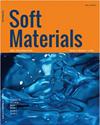Preparation and characterization of BN modified PA6/PC thermal conductive composites
IF 1.4
4区 材料科学
Q4 MATERIALS SCIENCE, MULTIDISCIPLINARY
引用次数: 0
Abstract
ABSTRACT In this paper, BN was used for composite modification of the PA6/PC incompatible blends, and the effects of BN filling amount on thermal conductivity of PA6/PC/BN multiphase composites were systematically studied. Results indicated that compared with single-phase matrix composites, the two-phase matrix exhibited slightly better thermal conductivity under the same amount of BN. At the same time, the thermal conductivity of PA6/PC/BN gradually increased with the increase in BN content. When the BN content was 33.33 wt%, the thermal conductivity of PA6/PC/BN composite reached the maximum value of 0.953 W/(m·K), which was about 4.5 times of the matrix. In addition, the content of BN had a great influence on the melting crystallization behavior of the composite, and the addition of BN had a significant increase in the crystallization temperature of the materials.BN改性PA6/PC导热复合材料的制备与表征
摘要本文采用BN对PA6/PC不相容共混物进行复合改性,系统研究了BN填充量对PA6/PC/BN多相复合材料导热性能的影响。结果表明,与单相基复合材料相比,在相同BN用量下,两相基复合材料的导热性能略好。同时,随着BN含量的增加,PA6/PC/BN的导热系数逐渐增大。当BN含量为33.33 wt%时,PA6/PC/BN复合材料的导热系数达到最大值0.953 W/(m·K),约为基体的4.5倍。此外,BN的含量对复合材料的熔融结晶行为有很大的影响,BN的加入对材料的结晶温度有显著的提高。
本文章由计算机程序翻译,如有差异,请以英文原文为准。
求助全文
约1分钟内获得全文
求助全文
来源期刊

Soft Materials
工程技术-材料科学:综合
CiteScore
2.90
自引率
0.00%
发文量
21
审稿时长
2.2 months
期刊介绍:
Providing a common forum for all soft matter scientists, Soft Materials covers theory, simulation, and experimental research in this rapidly expanding and interdisciplinary field. As soft materials are often at the heart of modern technologies, soft matter science has implications and applications in many areas ranging from biology to engineering.
Unlike many journals which focus primarily on individual classes of materials or particular applications, Soft Materials draw on all physical, chemical, materials science, and biological aspects of soft matter. Featured topics include polymers, biomacromolecules, colloids, membranes, Langmuir-Blodgett films, liquid crystals, granular matter, soft interfaces, complex fluids, surfactants, gels, nanomaterials, self-organization, supramolecular science, molecular recognition, soft glasses, amphiphiles, foams, and active matter.
Truly international in scope, Soft Materials contains original research, invited reviews, in-depth technical tutorials, and book reviews.
 求助内容:
求助内容: 应助结果提醒方式:
应助结果提醒方式:


